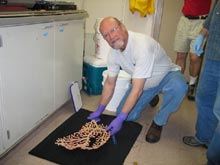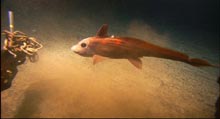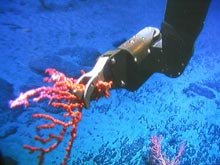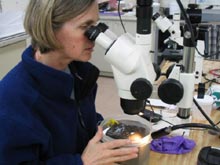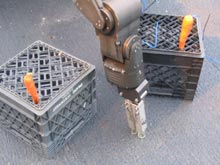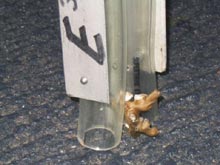Collecting larval recruitment blocks from Manning Seamount at about 1300 m depth. ![]() Click image to view a slide show.
Click image to view a slide show.
Up From the Ocean Bed
May 14, 2004
Mary Grady
Adjunct Earth Science Instructor
Northeastern University
I have no doubt that from however great a depth we may be able to bring up mud and stones from the bed of the ocean, we shall find them teeming with animal life . . .
—Sir James Clark Ross, 1841
![]() See The Deep Sea Fishes Of The New England Seamounts. (mp4, 3.57 MB)
See The Deep Sea Fishes Of The New England Seamounts. (mp4, 3.57 MB)
In the early morning hours, the science team achieved one of its main objectives: to collect the basalt blocks left behind by DSV Alvin last July and place them in Hercules' bio box. "I'm just delighted that we got them," said Dr. Lauren Mullineaux, who directs the experiment, in hopes of learning more about how deep-sea corals reproduce.
The search for the blocks began about 12:30 am, when Hercules reached Manning Seamount. Last year's position data from Alvin was not precise, so the ROV was put down in the approximate location. The science and ROV team then looked for markers. "We did a grid search pattern," Mullineaux said. "Peter Auster and Jon Moore, who made the drop last July, were both in the van to help us find the spot. We had a couple of miscues—one was a sea urchin, one was a couple of sponges—but then we found the bucket lids that marked the spot. It took us about two hours."
The 10-cm basalt cubes were left in two sites: a coral forest and an open area called "the plains." The substrate in both sites was similar. Mullineaux hoped to determine if new corals would colonize the blocks during the ten-month span. "I've done similar experiments on the Pacific seamounts and never got a coral," she said. This morning, she searched for growth on the basalt blocks with great anticipation. "I think there was a polyp," she said. "This is all about answering the question, Where are the babies? Because we seem to always observe just large colonies, and it raises the concern that if the adults are removed, how will the population recover? It means they could be very susceptible to disturbance." Dr. Mullineaux and research assistant Susan Mills may soon have some clues to begin answering these questions.
Today's dive on Manning Seamount is the longest so far on this expedition. Argus and Hercules were deployed about 10 last night and returned near 4 this afternoon. The science and ROV teams have been on rotating four-hour shifts during the entire dive. Unwilling to miss any of the action, many are in and out during their rest periods as well.
Life in the control van runs on a rhythm of its own. Hercules moves slowly, at a speed of two-tenths of a knot or less. Once a specimen is spotted, it is carefully observed, measured, and photographed. Hercules is then nudged into position on the bottom. The ROV manipulator arm reaches out and painstakingly works its way into the proper position to collect the sample, which is then placed in the bio box. The entire procedure can easily take the better part of an hour; yet the process captures the attention of everyone in the van.
The claw on the manipulator arm performed some tasks well, but had trouble with certain collections. Click image for larger view.
Research assistant Susan Mills examines the basalt blocks recovered from Manning Seamount. Click image for larger view.
The van is constructed with two tractor-trailer containers, positioned side by side. It is packed full of equipment, with just enough space for essential personnel and a few observers. The low ambient light allows a better view the wide video screens and computer terminals. To avoid distractions, the team keeps talk not related to the dive or sampling procedures to a minimum. At the ROV controls this morning, pilot Dave Wright watched over the shoulder of trainee pilot Tom Orvosh, guiding him through each maneuver. "The software is constantly being updated and tweaked, so it's a challenge to keep up with it," Wright said. "And this is our first trip with Hercules since last summer, so we are all just getting back up to speed."
At the science station in the control van, Dr. Mullineaux was flanked by Susan Mills and undergraduate student Katie Olds, each wearing headsets and keeping records. Biologist Dr. Jon Moore was seated near the main screen, watching for fish and sounding like a sports announcer as he kept a running commentary on the action. "There's an oreo," he said, "or as we like to say, 'Yet another oreo' . . . There's a burrowing urchin trail . . . These striations in the sediment are interesting." Dr. Mullineaux observed that the surface striation resembles that of a glacier, so perhaps the flow mechanics are similar. A video crew switched recorders off and on and kept track of the imagery. The ROV operators also interact with the ship's crew on the bridge, requesting that they adjust their position a few meters this way or that to better position Argus or move to a new site. The intercom chatter is nonstop. Every slow minute is packed with quiet activity and intense concentration.
A makeshift assemblage of milk crates and carrots simulates a seabed for testing the new claw. Click image for larger view.
The ROV crew designed and tested a new claw design, with a scissor-like edge and a flexible grip. Click image for larger view.
When Hercules returned to the surface, the bioboxes were unloaded and samples were transported to the cold room. Susan Mills examined each of the 10 recovered basalt blocks under the microscope. Halfway through her preliminary scans, she had already found anemone polyps, snails, isopods, and polychaetes. "There's more than I expected," she said. "I didn't really think we'd find much of anything."
Meanwhile, on the aft deck, the ROV crew tested an alternative claw for the manipulator arm. Several times during today’s dive, the claw had difficulty grasping and picking up the tiny, delicate objects selected by the science team. ROV crew members Dave Wright and Webb Pinner built a scissor-like grasper, and tested it out with a “seamount simulator” made from carrots jammed into a couple of milk crates. A second dive is scheduled for later this evening.
Sign up for the Ocean Explorer E-mail Update List.























